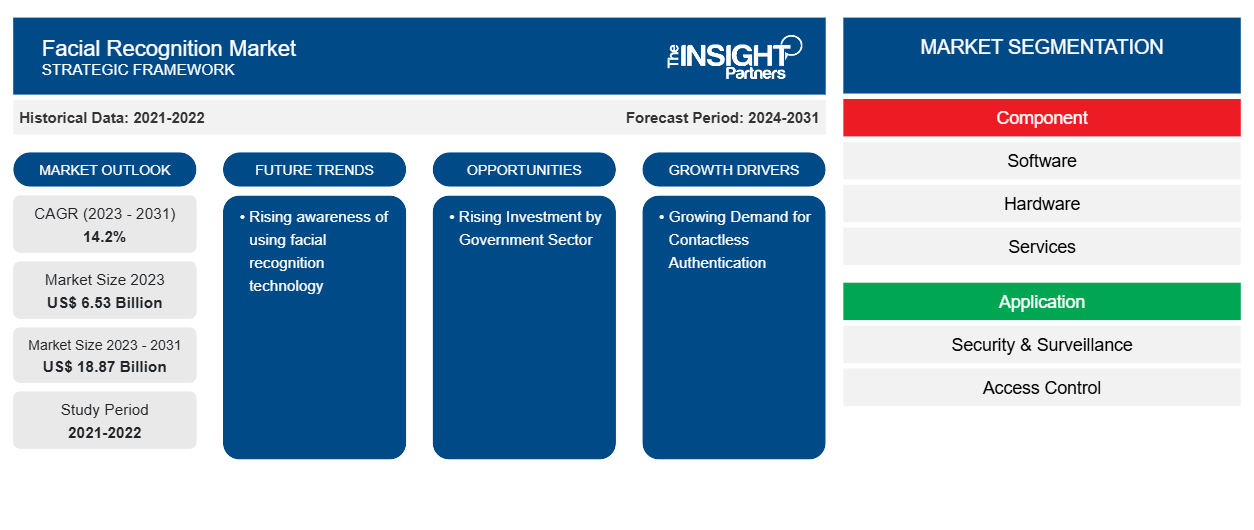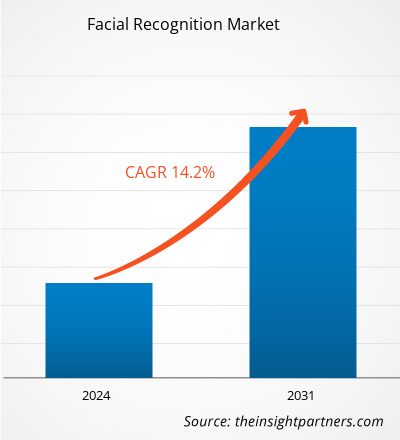The facial recognition market size is projected to reach US$ 18.87 billion by 2031 from US$ 6.53 billion in 2023. The market is expected to register a CAGR of 14.2% during 2023–2031. The rising awareness of using facial recognition technology is likely to remain a key trend in the market.
Facial Recognition Market Analysis
The growing requirement for effective video surveillance systems is driving up demand for facial recognition technologies. Facial recognition technology is being adopted by industries such as security and law enforcement, healthcare, retail, and transportation to improve security and safety.
Facial Recognition Market Overview
Face recognition is a type of biometric software that uses a person's facial traits to verify their identification. Facial recognition is a typical method used in security systems to identify specific people or users. One of the most frequent applications of face recognition is to unlock cell phones. The technique is also utilized in police enforcement, video monitoring, and passenger screening. Facial recognition mathematically maps a person's facial characteristics and stores the results as a faceprint. To validate an individual's identification, the program compares a distinct video or digital picture to a database of stored faceprints using deep learning techniques.
Customize This Report To Suit Your Requirement
You will get customization on any report - free of charge - including parts of this report, or country-level analysis, Excel Data pack, as well as avail great offers and discounts for start-ups & universities
Facial Recognition Market: Strategic Insights

-
Get Top Key Market Trends of this report.This FREE sample will include data analysis, ranging from market trends to estimates and forecasts.
Facial Recognition Market Drivers and Opportunities
Growing Demand for Contactless Authentication to Favor Market
The growing need for contactless authentication techniques, along with the availability of high-resolution cameras and the increasing use of smartphones equipped with face recognition capabilities, is propelling the facial recognition industry forward. This technology has uses in a variety of industries, including surveillance, banking, airports, and access control. The market is estimated to create large revenue and will continue to grow in the future years.
Rising Investment by Government Sector
The government segment consists of various government facilities, defense facilities, municipalities, utility stations, and others. Owing to the increasing emphasis on national security, governments across the world are investing significantly in advanced security solutions such as facial recognition systems. Also, the increasing emphasis on developing smart cities is among the other factors contributing to the adoption of facial recognition systems for enhanced security and surveillance applications, which drives the facial recognition market growth.
Facial Recognition Market Report Segmentation Analysis
Key segments that contributed to the derivation of the facial recognition market analysis are component, application, and vertical.
- Based on component, the market is segmented by software, hardware, and services. The hardware segment held a significant market share in 2023.
- Based on application, the market is segmented into security & surveillance, access control, and others. The security & surveillance segment held a larger market share in 2023.
- Based on vertical, the market is segmented into BFSI, retail & ecommerce, government, healthcare, education, automotive & transportation, and others. The BFSI segment held the largest share of the market in 2023.
Facial Recognition Market Share Analysis by Geography
The geographic scope of the facial recognition market report is mainly divided into five regions: North America, Asia Pacific, Europe, Middle East & Africa, and South & Central America.
North America dominated the market in 2023. Hence, any impact on the growth of industries is expected to affect the region's economic growth negatively. Despite several state and local regulations regulating facial recognition technology in the United States, impending conflicts persist. Facial recognition is predicted to rise significantly in the next years due to increased investment and enthusiasm by companies to embrace it. At the same time, US legislators and privacy groups are voicing concerns about the technology's potential societal effects and advocating for more regulation.
Facial Recognition Market Regional Insights
The regional trends and factors influencing the Facial Recognition Market throughout the forecast period have been thoroughly explained by the analysts at The Insight Partners. This section also discusses Facial Recognition Market segments and geography across North America, Europe, Asia Pacific, Middle East and Africa, and South and Central America.
Facial Recognition Market Report Scope
| Report Attribute | Details |
|---|---|
| Market size in 2023 | US$ 6.53 Billion |
| Market Size by 2031 | US$ 18.87 Billion |
| Global CAGR (2023 - 2031) | 14.2% |
| Historical Data | 2021-2022 |
| Forecast period | 2024-2031 |
| Segments Covered |
By Component
|
| Regions and Countries Covered |
North America
|
| Market leaders and key company profiles |
|
Facial Recognition Market Players Density: Understanding Its Impact on Business Dynamics
The Facial Recognition Market is growing rapidly, driven by increasing end-user demand due to factors such as evolving consumer preferences, technological advancements, and greater awareness of the product's benefits. As demand rises, businesses are expanding their offerings, innovating to meet consumer needs, and capitalizing on emerging trends, which further fuels market growth.

- Get the Facial Recognition Market top key players overview
Facial Recognition Market News and Recent Developments
The facial recognition market is evaluated by gathering qualitative and quantitative data post primary and secondary research, which includes important corporate publications, association data, and databases. A few of the developments in the facial recognition market are listed below:
- IDEMIA revealed VisionPass SP, its latest facial recognition solution for access control. IDEMIA enriched its product offer with VisionPass SP, a sleek and compact terminal with an eco-friendly design that provides accurate and fair matching results. (Source: IDEMIA, Press Release, January 2024)
- BAXE and Haventec partnered with IDEMIA to launch the first blockchain ecosystem using a facial authentication solution for identification. (Source: BAXE, Press Release, January 2022)
Facial Recognition Market Report Coverage and Deliverables
The “Facial Recognition Market Size and Forecast (2021–2031)” report provides a detailed analysis of the market covering below areas:
- Facial Recognition market size and forecast at global, regional, and country levels for all the key market segments covered under the scope
- Facial Recognition market trends as well as market dynamics such as drivers, restraints, and key opportunities
- Detailed PEST/Porter’s Five Forces and SWOT analysis
- Facial Recognition market analysis covering key market trends, global and regional framework, major players, regulations, and recent market developments
- Industry landscape and competition analysis covering market concentration, heat map analysis, prominent players, and recent developments for the Facial Recognition market
- Detailed company profiles
Frequently Asked Questions
Which region dominated the facial recognition market in 2023?
What are the driving factors impacting the facial recognition market?
What are the future trends of the facial recognition market?
Which are the leading players operating in the facial recognition market?
What would be the estimated value of the facial recognition market by 2031?
What is the expected CAGR of the facial recognition market?
- Historical Analysis (2 Years), Base Year, Forecast (7 Years) with CAGR
- PEST and SWOT Analysis
- Market Size Value / Volume - Global, Regional, Country
- Industry and Competitive Landscape
- Excel Dataset
Recent Reports
Related Reports
Testimonials
Reason to Buy
- Informed Decision-Making
- Understanding Market Dynamics
- Competitive Analysis
- Identifying Emerging Markets
- Customer Insights
- Market Forecasts
- Risk Mitigation
- Boosting Operational Efficiency
- Strategic Planning
- Investment Justification
- Tracking Industry Innovations
- Aligning with Regulatory Trends





















 Get Free Sample For
Get Free Sample For